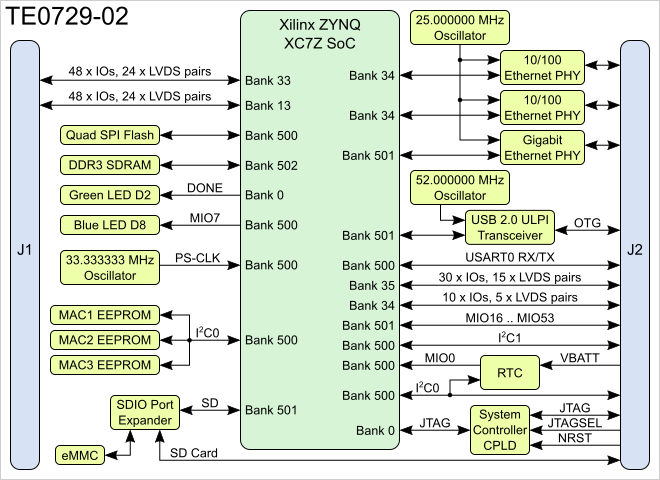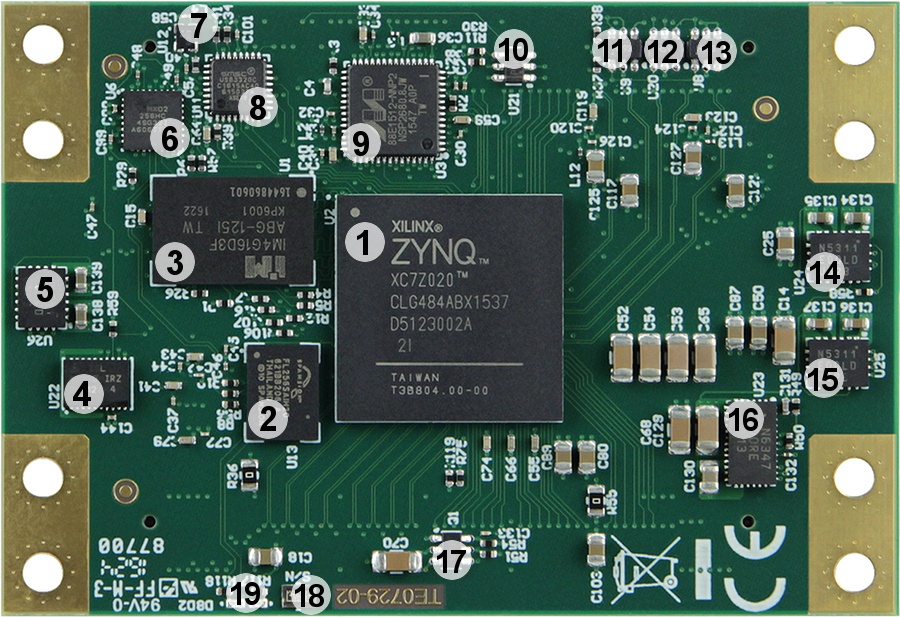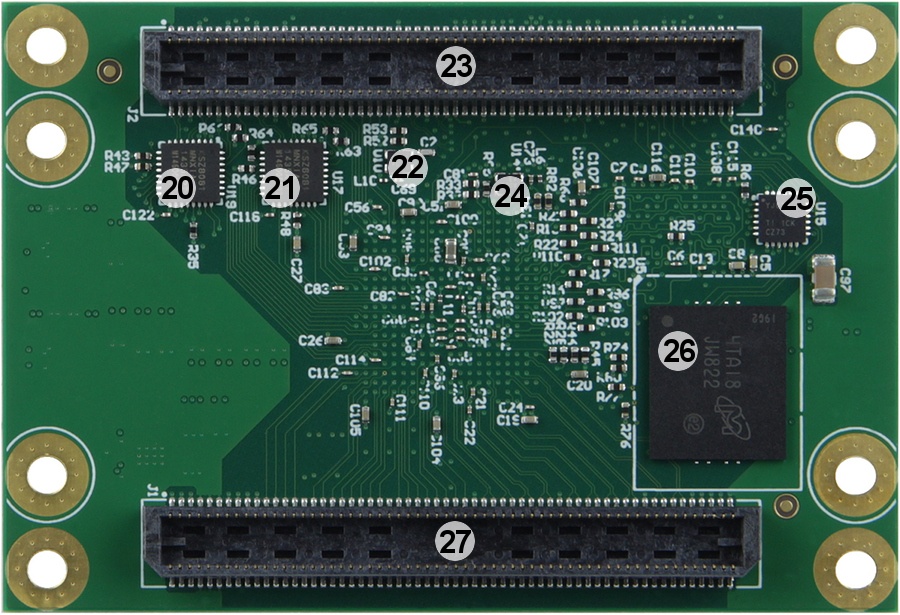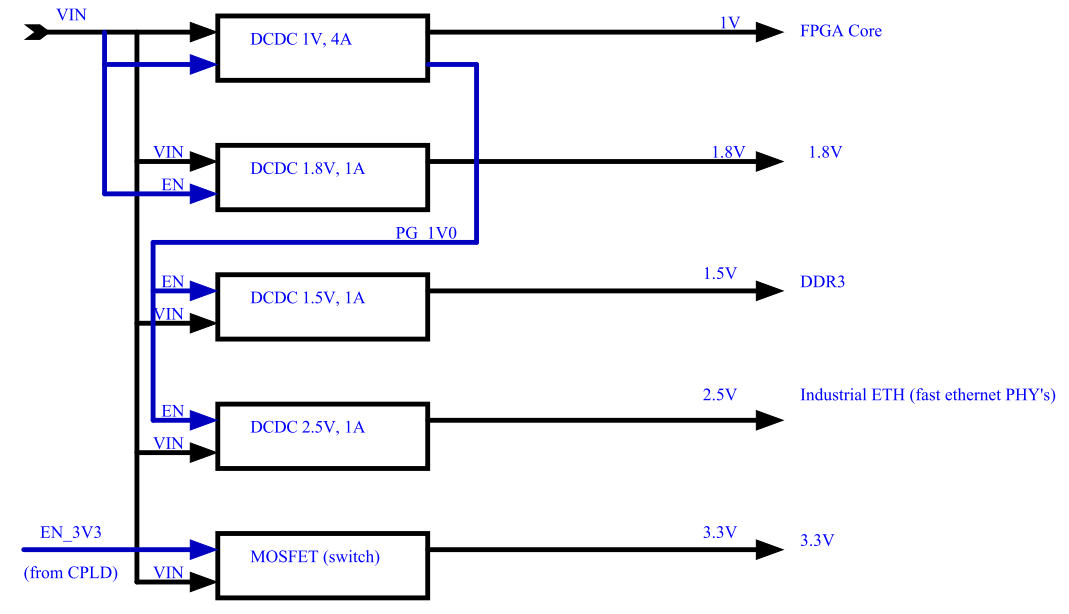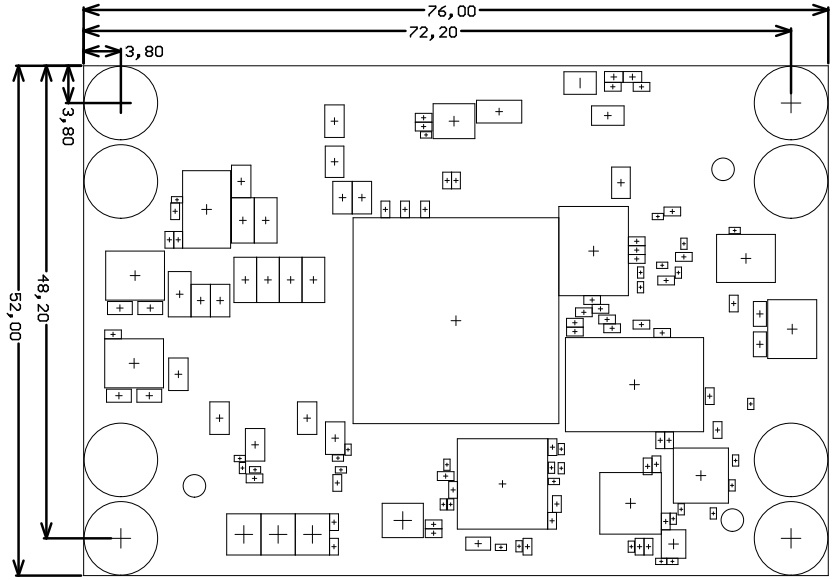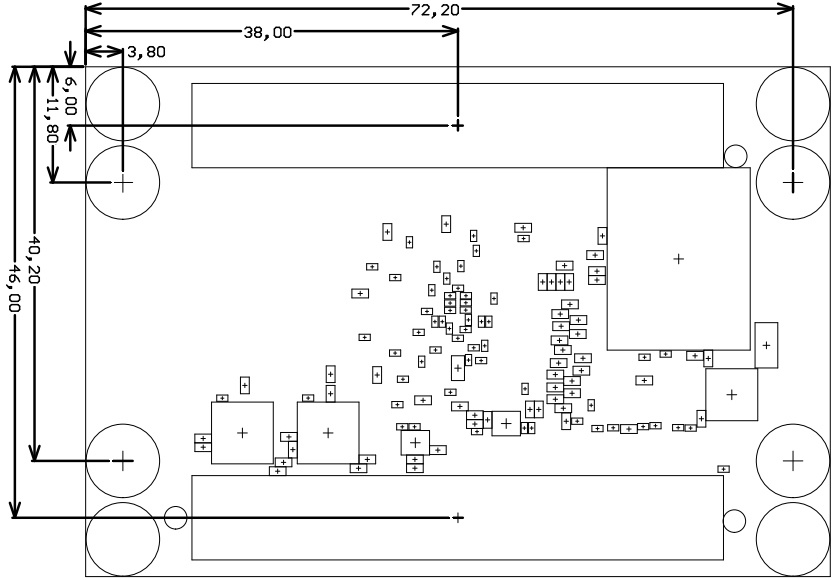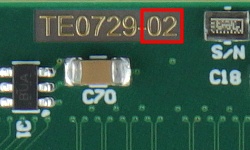Download PDF version of this document.
Table of Contents
Overview
The Trenz Electronic TE0729 is an industrial-grade SoM (System on Module) based on AMD Zynq-7000 SoC (XC7Z020).
Key Features
- Industrial-grade AMD Zynq-7000 (XC7Z020) SoM
- Dual-core ARM Cortex-A9 MPCore™ with CoreSight™
- 136 x FPGA I/Os (58 LVDS pairs possible)
- 8 x PS MIO pins
- 16-bit wide 512 MByte DDR3 SDRAM
- 32 MByte QSPI Flash memory
- 4 GByte eMMC Flash memory
- 1 x 10/100/1000 Mbps Ethernet transceiver PHY
- 2 x 10/100 Mbps Ethernet transceiver PHYs
- 3 x MAC address EEPROMs
- Hi-speed USB 2.0 ULPI transceiver with full OTG support
- Plug-on module with two 120-pin connectors
- Evenly spread supply pins for good signal integrity
- On-board high-efficiency DC-DC converters
- 6 A x 1.0 V power rail
- 3 A x 1.5 V power rail
- 3 A x 1.8 V power rail
- 3 A x 2.5 V power rail
- System management
- eFUSE bit-stream encryption
- AES bitstream encryption
- Temperature compensated RTC (real-time clock)
- User LED
- Rugged for shock and high vibration
Assembly options for cost or performance optimization available upon request.
Block Diagram
Main Components
- AMD Zynq-7000 all programmable SoC, U2
- 32 MByte quad SPI Flash memory, U13
- 4 Gbit DDR3/L SDRAM, U1
- Low-power RTC with battery backed SRAM, U22
- 3 A PowerSoC DC-DC converter (1.5V), U26
- System Controller CPLD, U6
- Low-power programmable oscillator @ 52.000000 MHz (OTG-RCLK), U12
- Hi-speed USB 2.0 ULPI transceiver, U11
- Gigabit Ethernet (GbE) transceiver, U3
- Ultra-low supply-current voltage monitor, U21
- 2K I2C serial EEPROM with EUI-48™ node identity, U9
- 2K I2C serial EEPROM with EUI-48™ node identity, U20
- 2K I2C serial EEPROM with EUI-48™ node identity, U8
- 3 A PowerSoC DC-DC converter (2.5V), U24
- 3 A PowerSoC DC-DC converter (1.8V), U25
- 6 A PowerSoC DC-DC converter (1.0V), U23
- 3 A PFET load switch with configurable slew rate (3.3V), Q1 (position changed for REV03)
- Serial number (traceability) pad (position on bottom for REV03).
- Green LED D2 and red LED D8
- 10Base-T/100Base-TX Ethernet PHY, U19
- 10Base-T/100Base-TX Ethernet PHY, U17
- Low-power programmable oscillator @ 25.000000 MHz (ETH_CLKIN), U10
- 120-pin double-row REF-189019-02 B2B connector, J2
- Low-power programmable oscillator @ 33.333333 MHz (PS-CLK), U14
- SDIO port expander with voltage-level translation, U15
- eMMC NAND Flash, U5
- 120-pin double-row REF-189019-02 B2B connector, J1
Initial Delivery State
| Storage device name | Content | Notes |
|---|---|---|
24AA025E48 EEPROMs | User content not programmed | Valid MAC address from manufacturer |
| eMMC Flash-Memory | Empty, not programmed | Except serial number programmed by flash vendor |
SPI Flash OTP Area | Empty, not programmed | Except serial number programmed by flash vendor |
SPI Flash Quad Enable bit | Programmed | |
SPI Flash main array | Demo design | |
eFUSE USER | Not programmed | |
eFUSE Security | Not programmed |
Signals, Interfaces and Pins
Board to Board (B2B) I/Os
| Bank | Type | B2B | IO count | IO Voltage | Notes |
|---|---|---|---|---|---|
| 500 | MIO | J2-87 J2-88 | 2 | 3.3 V | MIO0, MIO9 |
| 500 | MIO | J2-93 J2-95 J2-94 J2-96 | 4 | 3.3 V | Configured as I2C1 and USART0 by default, Configurable as GPIO by user |
| 13 | HR | J1 | 48 | User | |
| 33 | HR | J1 | 48 | User | |
| 35 | HR | J2 | 30 | 3.3 V | |
| 34 | GPIO | J2 | 10 | 2.5 V | Configured as DISP_RX by default, Configurable as GPIO by user |
For detailed information about the pin out, please refer to the Master Pin-out table.
JTAG Interface
JTAG access to the AMD Zynq-7000 device is provided through B2B connector J2.
| Signal | B2B Pin |
|---|---|
| TCK | J2-119 |
| TDI | J2-115 |
| TDO | J2-117 |
| TMS | J2-113 |
JTAGSEL pin 111 of B2B connector J2 should be kept low or grounded for normal operation.
System Controller I/O Pins
Special purpose pins used by TE0729:
| Name | Note |
|---|---|
| NRST | Reset-Signal from Watchdog, available at B2B J2-89 |
| NRST_IN | External Reset, available at B2B J2-91 |
For details see: TE0729 CPLD
On-board LEDs
There are 3 LED's on TE0729:
| LED | Color | Connected to | Notes |
|---|---|---|---|
| D1 | red | System Controller | Global Status LED |
| D2 | green | DONE | Inverted DONE, ON when FPGA not configured |
| D8 | red | MIO7 | OFF when PS7 not booted and not controlling MIO7 by software, else user controlled |
LED D2 is connected to the FPGA Done pin and will go off as soon as PL is configured.
This LED will not operate if the System Controller can not power on the 3.3V output rail that also powers the 3.3V circuitry on the module.
Clocking
| Clock | Frequency | IC | FPGA | Notes |
|---|---|---|---|---|
| PS-CLK | 33.333333 MHz | U14 | PS_CLK | PS subsystem main clock |
| ETH_CLKIN | 25.000000 MHz | U10 | - | Ethernet PHYs reference clock |
| 52.000000 MHz | U12 | - | USB PHY reference clock |
Default MIO mapping
| MIO | Configured as | B2B | Notes |
|---|---|---|---|
| 0 | GPIO | J2-87 | B2B |
| 1 | QSPI0 | - | SPI Flash-CS |
| 2 | QSPI0 | - | SPI Flash-DQ0 |
| 3 | QSPI0 | - | SPI Flash-DQ1 |
| 4 | QSPI0 | - | SPI Flash-DQ2 |
| 5 | QSPI0 | - | SPI Flash-DQ3 |
| 6 | QSPI0 | - | SPI Flash-SCK |
| 7 | GPIO | - | Red LED D8 |
| 8 | - | - | QSPI feedback clock |
| 9 | GPIO | J2-88 | B2B |
| 10 | I2C0 SDA | J2-90 | B2B |
| 11 | I2C0 SCL | J2-92 | B2B |
| 12 | I2C1 SDA | J2-93 | B2B (SDA on-board I2C, also configurable as GPIO by user) |
| 13 | I2C1 SCL | J2-95 | B2B (SCL on-board I2C, also configurable as GPIO by user) |
| 14 | USART0 RX | J2-94 | B2B (RX on-board UART, also configurable as GPIO by user) |
| 15 | USART0 TX | J2-96 | B2B (TX on-board UART, also configurable as GPIO by user) |
| 16..27 | ETH0 | Ethernet RGMII PHY | |
| 28..39 | USB0 | USB ULPI PHY | |
| 40 | SDIO0 | J2-100 | |
| 41 | SDIO0 | J2-102 | |
| 42 | SDIO0 | J2-104 | |
| 43 | SDIO0 | J2-106 | |
| 44 | SDIO0 | J2-108 | |
| 45 | SDIO0 | J2-110 | |
| 46 | GPIO | - | RTC Interrupt |
| 47 | - | - | - |
| 48 | GPIO | SEL_SD | SD Card multiplexer control |
| 49 | GPIO | - | USB Reset |
| 50 | GPIO | - | ETH0 Interrupt |
| 51 | GPIO | - | ETH0 Reset |
| 52 | ETH0 | - | MDC |
53 | ETH0 | - | MDIO |
Boot Modes
TE0729 supports primary boot from
- JTAG
- SPI Flash
- SD Card
Boot from on-board eMMC is also supported as secondary boot (FSBL must be loaded from SPI Flash).
The boot modes are controlled by the Pins 'BOOT1' and 'BOOT2' on the board to board (B2B) connector. Pins routed through the CPLD by default firmware with pull-up, if not connected on B2B.
BOOTMODE2 (M3) | BOOTMODE1 (M2) | M1 | M0 | Boot mode |
|---|---|---|---|---|
| LOW | LOW | LOW | LOW | JTAG |
| LOW | HIGH | LOW | LOW | Invalid |
| HIGH | LOW | LOW | LOW | SPI (eMMC as secondary boot possible) |
| HIGH | HIGH | LOW | LOW | SD Card |
Processing System (PS) Peripherals
| Peripheral | IC | Designator | PS | MIO | Notes |
|---|---|---|---|---|---|
| EEPROM I2C | 24AA025E48T-I/OT | U8 | I2C0 | MIO10, MIO11 | MAC Address |
| EEPROM I2C | 24AA025E48T-I/OT | U9 | I2C0 | MIO10, MIO11 | MAC Address |
| EEPROM I2C | 24AA025E48T-I/OT | U20 | I2C0 | MIO10, MIO11 | MAC Address |
| RTC | ISL12020MIRZ | U22 | I2C0 | MIO10, MIO11 | Temperature compensated real time clock |
| RTC Interrupt | ISL12020MIRZ | U22 | GPIO | MIO46 | Real Time Clock Interrupt |
| SPI Flash | S25FL256SAGBHI20 | U13 | QSPI0 | MIO1..MIO6 | |
| Ethernet0 10/100/1000 Mbps PHY | 88E1512-A0-NNP2I000 | U3 | ETH0 | MIO16...MIO27 | |
| Ethernet0 10/100/1000 Mbps PHY Reset | GPIO | MIO51 | |||
| Ethernet1 10/100 Mbps PHY | KSZ8081MLXCA | U17 | - | (EMIO) | |
| Ethernet1 10/100 Mbps PHY Reset | - | (EMIO) | |||
| Ethernet2 10/100 Mbps PHY | KSZ8081MLXCA | U19 | - | (EMIO) | |
| Ethernet2 10/100 Mbps PHY Reset | - | (EMIO) | |||
| USB | USB3320C-EZK | U11 | USB0 | MIO28...MIO39 | |
| USB Reset | GPIO | MIO49 | |||
| eMMC (embedded eMMC) | MTFC4GMVEA-4M IT | U5 | SDIO0 | MIO40...MIO45 |
I2C Interface
The on-board I2C components are connected to MIO10 and MIO11 and configured as I2C0 by default.
I2C addresses for on-board components
| Device | I2C-Address | Notes |
|---|---|---|
| EEPROM for MAC1 | 0x50 | |
| EEPROM for MAC2 | 0x51 | |
| EEPROM for MAC3 | 0x52 | |
| RTC | 0x6F | |
| Battery backed RAM | 0x57 | Integrated in RTC |
On-board Peripherals
Gigabit Ethernet
The TE0729 is equipped with a Marvell Alaska 88E1512 Gigabit Ethernet PHY (U3) connected to PS Ethernet GEM0 (referenced in this manual Ethernet0). The I/O Voltage is fixed at 1.8V. The reference clock input of the PHY is supplied from an on board 25MHz oscillator (U10).
Ethernet0 PHY connection:
| PHY PIN | ZYNQ PS | Notes |
|---|---|---|
| MDC/MDIO | MIO52, MIO53 | - |
| LED0 | - | pin J2-57 on B2B connector |
| LED1 | - | pin J2-59 on B2B connector |
| LED2/Interrupt | MIO46 | - |
| CONFIG | - | Connected to GND, PHY Address 0 |
| RESETn | MIO51 | - |
| RGMII | MIO16..MIO27 | - |
| SGMII | - | B2B J2 |
| MDI | - | B2B J2 |
The TE0729 SoM is also equipped with two additional Microchip KSZ8081MLXCA Ethernet PHY's (IC's U17 and U19) to provide further 10/100 Mbps Ethernet interfaces with the identifiers Ethernet1 and Ethernet2. The reference clock input of both PHYs is supplied from the same 25 MHz oscillator (U10), which also provides Ethernet0 Gigabit PHY with a reference clock signal.
Ethernet1 PHY connection to B2B-connectors:
| PHY PIN | B2B | Notes |
|---|---|---|
| ETH1_RX_P | J2-26 | - |
| ETH1_RX_N | J2-28 | - |
| ETH1_TX_P | J2-20 | - |
| ETH1_TX_N | J2-22 | - |
| ETH1_LED0 | J2-34 | Status LED |
| ETH1_LED1 | J2-32 | Transmission LED |
Ethernet2 PHY connection to B2B-connectors:
| PHY PIN | B2B | Notes |
|---|---|---|
| ETH2_RX_P | J2-2 | - |
| ETH2_RX_N | J2-4 | - |
| ETH2_TX_P | J2-8 | - |
| ETH2_TX_N | J2-10 | - |
| ETH2_LED0 | J2-16 | Status LED |
| ETH2_LED1 | J2-14 | Transmission LED |
All other pins of the PHYs are connected to Bank34 of Zynq, see schematic for further details.
USB Interface
Microchip USB3320 is connected via ULPI interface to the Zynq PS USB0. I/O voltage level is fixed at 1.8V and PHY reference clock input is supplied from the on-board 52.000000 MHz oscillator (U12).
PHY connection:
| PHY Pin | Zynq Pin | B2B Name | Notes |
|---|---|---|---|
| ULPI | MIO28..39 | - | Zynq USB0 MIO pins are connected to the PHY |
| REFCLK | - | - | 52MHz from on board oscillator (U12) |
| REFSEL[0..2] | - | - | All three connected to the GND, selects 52.000000 MHz as reference clock |
| RESETB | MIO49 | - | Active-low reset |
| CLKOUT | MIO36 | - | Connected to 1.8V, selects reference clock operation mode |
| DP,DM | - | OTG_D_P, OTG_D_N | USB data lines |
| CPEN | - | VBUS_V_EN | External USB power switch active-high enable signal |
| VBUS | - | USB_VBUS | Connected to the USB-VBUS via resistor. Check reference schematic |
| ID | - | OTG_ID | For an A-Device connected to the ground, for a B-Device left floating |
The schematic for the USB connector and required components is different depending on the USB usage. USB standard A or B connectors can be used for Host or Device modes. A Mini USB connector can be used for USB Device mode. A USB Micro connector can be used for Device mode, OTG Mode or Host Mode.
RTC - Real Time Clock
An Intersil temperature compensated real time clock IC ISL12020MIRZ is used for timekeeping (U22). Battery voltage must be supplied to the module from the main board.
Battery backed registers are accessed at I2C slave address 0x57. General purpose RAM is accessed at I2C slave address 0x6F. This RTC IC is supported by the Linux OS, so it can be used as hwclock device.
MAC-Address EEPROMs
TE0729 module has three Microchip 24AA025E48 EEPROMs (U8, U9 and U20) which contain globally unique EUI-48TM compatible 48-bit node (MAC) addresses. These EEPROMs are organized as two blocks of 128 x 8-bit memory. One of the blocks stores the 48-bit node address and is write protected, the other block is available for application use. EEPROMs are accessible using I2C slave address 0x50 for MAC-Address1 (U8), 0x51 for MAC-Address2 (U9), 0x52 for MAC-Address3 (U20).
Watchdog
TE0729 has support for hardware watchdog function. By default the watchdog is disabled at power up. Please contact Trenz Electronic for details how to enable watchdog function.
Power and Power-On Sequence
For startup, a power supply with minimum current capability of 3 A is recommended.
VIN and 3.3VIN can be connected to the same source (3.3 V).
Power Supplies
Supply Voltage | Voltage Range | Notes |
|---|---|---|
VIN | 3.3 V |
Bank Voltages
| Bank | Voltage | Max. Value | Notes |
|---|---|---|---|
| 501 | 1.8 V | - | ETH0 / USB0 / SDIO0 |
| 500 | 3.3 V | - | SPI / I2C / UART |
| 502 | 1.5 V | - | DDR3-RAM |
| 13 | user | 3.3 V | connected to 3.3V by default by 0-Ohm-Resistor R36 |
| 33 | user | 3.3 V | connected to 3.3V by default by 0-Ohm-Resistor R55 |
| 34 | 2.5 V | - | ETH / DISP |
| 35 | 3.3 V | - | GPIO |
Power-up sequence at start-up
The Trenz TE0729 is equipped with several DC-DC-voltage-regulators to generate the required on-board voltages with the values 1V (FPGA core), 1.8 V (VCC0 MIO, VCCAUX, AVCC, VCCPLL, VDD USB and ETH PHYs), 1.5V (DDR3), 2.5V (Industrial fast ETH-PHYs) and 3.3V (VCCIO, peripheral components).
In the first step at device start-up the voltages 1V and 1.8V are generated for the FPGA core and programmable logic banks. The voltages 1.5V and 2.5 V are enabled after the voltage 1V has stabilized. The voltage 3.3V is enabled by the CPLD system controller at last.
The voltage 3.3V is available on B2B-connector at pins J1-65, J1-66 and an indicator for stabilized on-board voltages in steady state.
Pay attention to the voltage level of the I/O-signals, which must not be higher than VCCIO + 0.4V.Board to Board Connectors
The TE0729 module has two 120-pin double-row REF-189019-02 connectors on the bottom side which are compatible with Samtec BSE-060-01-L-D-A connectors. Mating connectors on the baseboard are REF-189019-01, which are compatible with Samtec BTE-060-01-L-D-A connectors.
Order | REF Number | Samtec Number | Type | Mated Height | Data sheet | Comment |
|---|---|---|---|---|---|---|
| - | REF-189019-02 | BTE-060-01-L-D-A-K-TR | Module connector | 5 mm | http://suddendocs.samtec.com/catalog_english/bte.pdf | Standard connector used on module |
| 26663 | REF-189019-01 | BSE-060-01-L-D-A-TR | Baseboard connector | 5 mm | http://suddendocs.samtec.com/catalog_english/bse.pdf | Standard connector used on board |
| Connector Specifications | Value |
|---|---|
| Insulator material | Liquid crystal polymer |
| Stacking height | 5 mm |
| Contact material | Phosphor-bronze |
| Plating | Au or Sn over 50 μ" (1.27 μm) Ni |
| Current rating | 2 A per pin (1 pin powered per row) |
| Operating temperature range | -55 °C to +125 °C |
| Voltage rating | 225 VAC with 5 mm stack height |
| Max cycles | 100 |
| RoHS compliant | Yes |
Technical Specification
Absolute Maximum Ratings
| Parameter | Min | Max | Units | Notes |
|---|---|---|---|---|
VIN supply voltage | -0.1 | 3.75 | V | |
| VBAT supply voltage | -0.3 | 6.0 | V | |
| PL I/O bank supply voltage for HR I/O banks (VCCO) | -0.5 | 3.6 | V | |
| I/O input voltage for HR I/O banks | -0.55 | VCCO_X+0.55 | V | |
Voltage on module JTAG pins | -0.4 | VCCO_0+0.55 | V | VCCO_0 is 3.3V nominal |
Storage temperature | -40 | +85 | C | |
| Storage temperature without the ISL12020MIRZ | -55 | +100 | C |
Recommended Operating Conditions
| Parameter | Min | Max | Units | Notes | Reference document |
|---|---|---|---|---|---|
| VIN supply voltage | 3.135 | 3.465 | V | ||
| VBAT supply voltage | 1.8 | 5.5 | V | ||
| PL I/O bank supply voltage for HR I/O banks (VCCO) | 1.14 | 3.465 | V | AMD document DS191 | |
| I/O input voltage for HR I/O banks | (*) | (*) | V | (*) Check datasheet | AMD document DS191 and DS187 |
| Voltage on module JTAG pins | 3.135 | 3.465 | V | VCCO_0 is 3.3 V nominal |
Physical Dimensions
Please download the assembly diagram for exact values.
Module size: 76 mm × 52 mm.
Mating height with standard connectors: 5 mm.
PCB thickness: 2 mm.
All dimensions are shown in millimeters.
Operating Temperature Ranges
Commercial grade modules
All parts are at least commercial temperature range of 0°C to +70°C.
Industrial grade modules
All parts are at least industrial temperature range of -40°C to +85°C.
The module operating temperature range depends on customer design and cooling solution. Please contact us for options.
Weight
Weight | Part |
|---|---|
21.6 g | Plain module |
Revision History
Hardware Revision History
| Date | Revision | Changes |
|---|---|---|
| 2023-12-01 | 03 |
|
| 2016-05-02 | 02 | First production release |
| - | 01 | Prototypes |
Hardware revision number is written on the PCB board together with the module model number separated by the dash.
Document Change History
| Date | Revision | Contributors | Description |
|---|---|---|---|
| |||
2022-07-13 | v.30 | Martin Rohrmüller |
|
2018-08-29 | v.29 | John Hartfiel |
|
| 2017-11-06 | v.28 | Ali Naseri |
|
| 2017-06-18 | v.22 | Jan Kumann |
|
| 2017-06-07 | v.21 | Jan Kumann |
|
2017-05-22 | v.12 | Jan Kumann |
|
| 2017-03-24 | v.11 | John Hartfiel |
|
| 2016-06-14 | v.10 | Ali Naseri |
|
Disclaimer
Data Privacy
Please also note our data protection declaration at https://www.trenz-electronic.de/en/Data-protection-Privacy
Document Warranty
The material contained in this document is provided “as is” and is subject to being changed at any time without notice. Trenz Electronic does not warrant the accuracy and completeness of the materials in this document. Further, to the maximum extent permitted by applicable law, Trenz Electronic disclaims all warranties, either express or implied, with regard to this document and any information contained herein, including but not limited to the implied warranties of merchantability, fitness for a particular purpose or non infringement of intellectual property. Trenz Electronic shall not be liable for errors or for incidental or consequential damages in connection with the furnishing, use, or performance of this document or of any information contained herein.
Limitation of Liability
In no event will Trenz Electronic, its suppliers, or other third parties mentioned in this document be liable for any damages whatsoever (including, without limitation, those resulting from lost profits, lost data or business interruption) arising out of the use, inability to use, or the results of use of this document, any documents linked to this document, or the materials or information contained at any or all such documents. If your use of the materials or information from this document results in the need for servicing, repair or correction of equipment or data, you assume all costs thereof.
Copyright Notice
No part of this manual may be reproduced in any form or by any means (including electronic storage and retrieval or translation into a foreign language) without prior agreement and written consent from Trenz Electronic.
Technology Licenses
The hardware / firmware / software described in this document are furnished under a license and may be used /modified / copied only in accordance with the terms of such license.
Environmental Protection
To confront directly with the responsibility toward the environment, the global community and eventually also oneself. Such a resolution should be integral part not only of everybody's life. Also enterprises shall be conscious of their social responsibility and contribute to the preservation of our common living space. That is why Trenz Electronic invests in the protection of our Environment.
REACH, RoHS and WEEE
REACH
Trenz Electronic is a manufacturer and a distributor of electronic products. It is therefore a so called downstream user in the sense of REACH. The products we supply to you are solely non-chemical products (goods). Moreover and under normal and reasonably foreseeable circumstances of application, the goods supplied to you shall not release any substance. For that, Trenz Electronic is obliged to neither register nor to provide safety data sheet. According to present knowledge and to best of our knowledge, no SVHC (Substances of Very High Concern) on the Candidate List are contained in our products. Furthermore, we will immediately and unsolicited inform our customers in compliance with REACH - Article 33 if any substance present in our goods (above a concentration of 0,1 % weight by weight) will be classified as SVHC by the European Chemicals Agency (ECHA).
RoHS
Trenz Electronic GmbH herewith declares that all its products are developed, manufactured and distributed RoHS compliant.
WEEE
Information for users within the European Union in accordance with Directive 2002/96/EC of the European Parliament and of the Council of 27 January 2003 on waste electrical and electronic equipment (WEEE).
Users of electrical and electronic equipment in private households are required not to dispose of waste electrical and electronic equipment as unsorted municipal waste and to collect such waste electrical and electronic equipment separately. By the 13 August 2005, Member States shall have ensured that systems are set up allowing final holders and distributors to return waste electrical and electronic equipment at least free of charge. Member States shall ensure the availability and accessibility of the necessary collection facilities. Separate collection is the precondition to ensure specific treatment and recycling of waste electrical and electronic equipment and is necessary to achieve the chosen level of protection of human health and the environment in the European Union. Consumers have to actively contribute to the success of such collection and the return of waste electrical and electronic equipment. Presence of hazardous substances in electrical and electronic equipment results in potential effects on the environment and human health. The symbol consisting of the crossed-out wheeled bin indicates separate collection for waste electrical and electronic equipment.
Trenz Electronic is registered under WEEE-Reg.-Nr. DE97922676.
